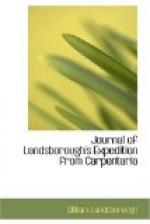the country should be boiled down for tallow when
Australia is the finest country in the world for growing
wool. He hoped that the discoveries made through
the instrumentality of the Royal Society would tend
to prevent this. He would now point out the route
which he took in search of Burke and his party.
In his first expedition he proceeded in the direction
of Central Mount Stuart, with the view of trying to
discover whether Burke had gone on Stuart’s
route; he succeeded in travelling about 210 miles,
the first 100 of which he followed up a running stream,
but after leaving its source he lost much time from
the scarcity of water; for this reason, and the precious
loss of time caused by the wreck of the Firefly, he
deemed it prudent to return to the depot; this course
was adopted with much regret, as the wet season had
commenced, a continuance of which for two or three
weeks would probably have enabled him to have pursued
the route originally intended in search of the traces
of Burke. His first impression regarding the
stream referred to was that it was created by rain,
but as it was evident that no rain had fallen for months
he concluded that this idea was incorrect. He
afterwards discovered that it owed its source to springs
of a kind which he had never before met with, the
stream from which, near its source in the valley of
the Gregory River, was sufficiently powerful to turn
a large mill wheel. On his route back to the
depot he found that this stream, at a point distant
from Carpentaria about 80 miles, divided into two
branches, one of which flowed into the Nicholson River,
and the other into the Albert. As an evidence
of the superior quality of the country through which
he passed on his expedition to the south-west he might
mention that the horses travelled as well as if they
had been stable fed. He had travelled in Queensland
and New South Wales and had never found horses stand
work as well as those horses did at Carpentaria.
On returning to the depot he and his party rested
for three weeks and again started to find the tracks
of Burke and his companions. They had heard that
tracks had been seen by Mr. Walker on the Flinders
River, they tried to follow Walker’s tracks to
the Flinders, but although he had preceded them only
by about two months, his tracks could not be followed,
owing to the rain which had fallen. They proceeded
to the Flinders, but they could find no traces of Burke.
They followed up the river for about 280 miles through
a magnificent country. When they reached this
point they left the Flinders, and in less than twenty
miles further got to the watershed of the Thomson,
one of the main heads of the Cooper River. When
they had proceeded about 100 miles down the valley
of the Thomson they found a tree which had been marked
by a companion of Landsborough’s in a former
expedition several years before, which he was glad
to be able to show, as a proof of his knowledge of
the country, to the members of his party who knew




